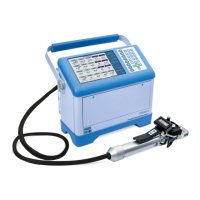CIRAS-3 Operation Manual V. 1.09 72 support@ppsystems.com
practical – this way you will have both hands free and avoid unnecessary changes to natural leaf
orientation, and you can position all leaves in a uniform orientation to the sun when the LED light unit is
not in use.
With the leaf enclosed in the cuvette you should quickly notice a series of dynamic leaf responses,
assuming ideal physiological conditions. Sub-stomatal CO
2
concentration (Ci) will begin to fall, after
being initially equal to or higher than the reference CO
2
concentration (CO2r). When Ci<CO2r there is an
instantaneous change in calculated net photosynthesis (A), from a negative rate (respiration) to a positive
rate. Simultaneously, the differential CO
2
concentration (CO2d) will go into negative values while
differential humidity (H2Od) becomes positive – the leaf is both fixing carbon dioxide and transpiring
water vapor. Be aware of the leaf’s light history and consider how that affects the chamber acclimation
phase – a highly-shade tolerant plant or shade leaf will require different acclimation in the leaf chamber
than a shade-intolerant or sun leaf. Consider also seasonal affects and leaf ontogeny – reduced rates of
metabolism can often be expected despite year-round plant culture in artificial (indoor) environments.
Note that some physiological variables, especially A, gs (stomatal conductance) and CO2d will continue
changing as the leaf acclimates and approaches a stable state. This can require several seconds and as
long as several minutes. This depends largely on the preconditioned state of the plant relative to the
environmental conditions inside the cuvette. A useful illustration of this can be seen with a highly shade-
adapted plant that is suddenly exposed to strong light intensities in the leaf chamber. In this case,
delayed gas exchange responses can be expected compared to a plant (or leaf) accustomed to more
intense light conditions. If your goal is to collect a large quantity of relatively short duration
measurements from a large sample group of plants/leaves, especially when allowing ambient light and/or
temperature conditions to prevail, you will probably use the Manual Recording option. This allows you
maximum flexibility as to when to capture a reading and when to wait.
Additional Filtering in Dirty/Dusty Environments
If working in extreme dirty/dusty environments, we strongly recommend
using the external air in filter (included in your CIRAS-3 spares kit). It
easily connects to the CIRAS-3 “AIR IN” port as shown here.

